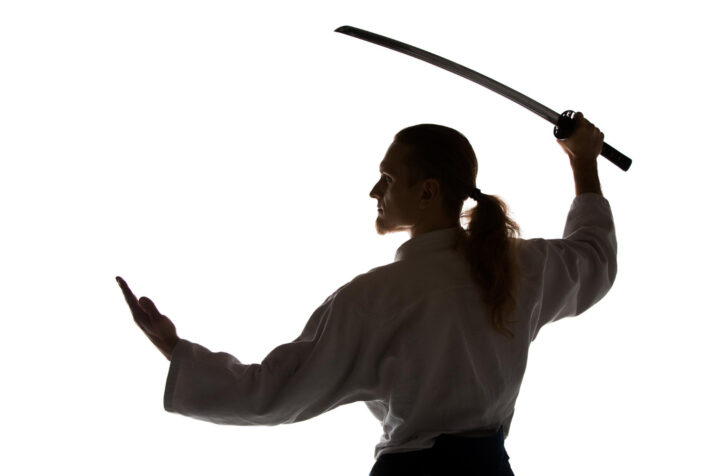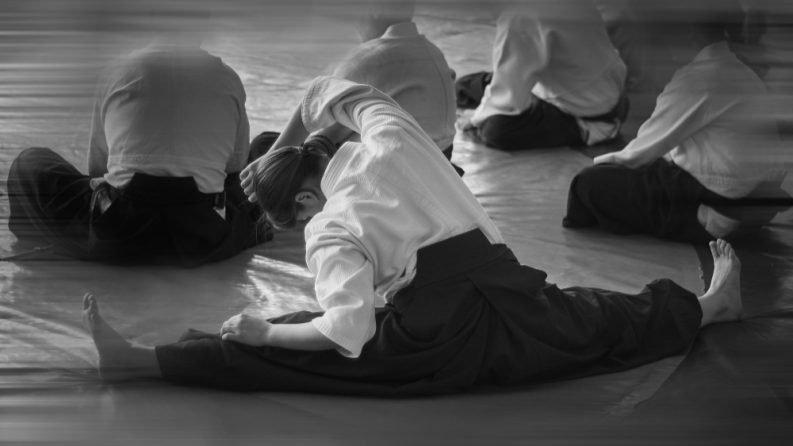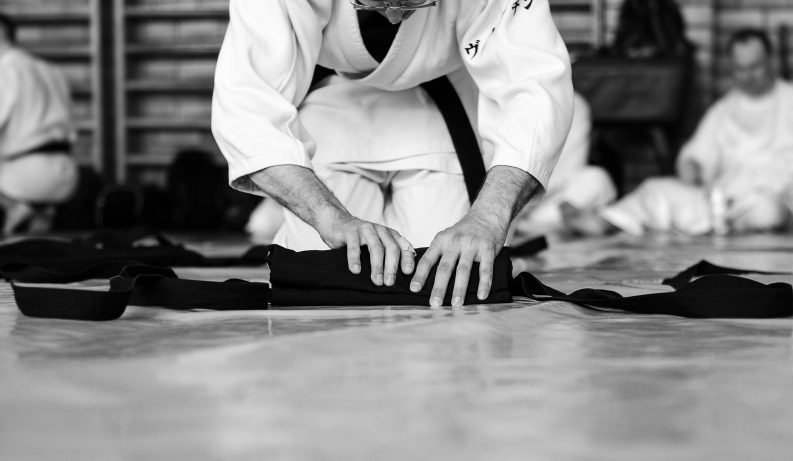Iaidō (居合道 Japanese for “way of drawing the sword”) is the Japanese art of drawing with the katana and belongs to the large field of Budō disciplines. The peculiarity is that the sword is drawn in such a way that it can be used as a weapon while still being drawn.
The Japanese Martial Art – Iaido
Iaido places great emphasis on the correctness of forms (Kata), the precision and efficiency of movement, and mental focus. Practitioners of the art – Iaidoka – use Real Katana (or Blunt Training Swords – Iaito – which are still quite dangerous), so it is primarily a single art. Training is done by performing Kata or set forms that teach how to respond to attacks from opponents in various positions and situations.
The Iaidō reflects the Zen philosophy. One does not fight against a real opponent, but one “mirrors” oneself. In this way, one tries to develop one’s skills and personality.
Many techniques take place in a kneeling position (seiza), while others start in a half-kneeling position or standing. The ideal is to be able to deal with an attack at any time, no matter what situation you are in. The character 居 “i” means “to be” (especially “to sit”) in a particular place, while 合 “ai” means “to fit” or “to respond”. Taken together, the name can be interpreted as “the way to respond appropriately to any situation you find yourself in.”

Iaido – History
On the battlefields of medieval Japan, samurai were armed with various weapons such as bows, spears, halberds, and eventually firearms. But when these weapons failed, or when the battle came down to hand-to-hand combat, the ability to quickly draw the sword and attack was essential.
The exquisite sharpness of the Japanese Sword meant that fights could end an instant after they began, so quick action without wasted movement made the difference between life and death.
Batto (“sword drawing”) was taught as one of the many martial arts required for samurai. Schools of swordsmanship developed that placed great emphasis on initial drawing and cutting. The name Iaido came later.
In the 16th century, Hayashizaki Jinsuke Shigenobu Shin founded Muso Hayashizaki-ryu, a school of iaido that spread throughout Japan and branched out into numerous other traditions or ryuha. Today, Muso Shinden-ryu, Muso Jikiden Eishin-ryu, Tamiya-ryu and Mugai-ryu are the most popular, but there are dozens if not hundreds of other styles. Each has its own stylistic differences and approaches to training.
Iaido and Kendo have a special relationship and are sometimes referred to as “two wheels of the same cart,” with many people practicing both arts. Kendo teaches distance and timing with a live opponent, while Iaido teaches the proper use of a real sword.
What Happens during Iaido Training?
Beginners first learn proper posture, footwork and etiquette and how to properly hold and cut the sword. Beginners can start with a bokuto (or Bokken or wooden sword). Advanced students practice in traditional attire (hakama and keikogi) and then use an Iaitō, a blunt practice sword, to correctly learn the techniques of drawing (nuki), one or two-handed handling, and returning the sword to the scabbard (noto). (Tip: All katana in our store are also available in blunt version – as Iaito).
Real Katana are both dangerous and expensive, so Iaidoka usually switch to using a real blade only after several years of practice (usually after reaching 4th or 5th dan).

After stretching and warming up, the practice begins with a bow to the Shomen, the “peak” or “front” of the room, a bow to the Sensei, and a respectful bow to one’s own sword. The Katana is then tucked into the belt. Sessions often start with a repetition and practice of basic cutting, then move on to practicing kata forms. This can be done together with the group or individually and at your own pace. In either case, the Sensei will offer correction points to help you get closer to the ideal technique.
Kata Form Drills
Martial arts in medieval Japan were traditionally practiced using Kata or forms. Through repeated practice of established forms, users internalized the logical application of techniques to different situations and perfected their foundational movements.
When it came to a real fight, the swordsman could react instinctively without having to think.
Iaido forms generally consist of 4 parts:
- Drawing the sword and the initial cut (called Nukitsuke).
- The finishing downward strike (called Kiriotoshi).
- A symbolic cleaning of blood from the blade (known as Chiburi or Chiburui).
- Sheathing the blade (Noto).
Each Kata deals with a specific situation. For instance, the initial Kata in many schools involves an opponent sitting opposite you. Later Kata may become more complex, adding multiple attackers approaching from different directions. The goal in each case is to eliminate adversaries intent on killing you, always without giving the enemy any openings or vulnerabilities to exploit.
For this reason, it’s crucial to be aware of one’s posture and positioning, and to move efficiently with maximum power. Different schools may place varying emphasis on speed or on “beautiful” technique. However, it’s generally accepted that graceful movements are efficient and efficient movements can be executed the fastest.

Rank and Competitions
Iaido ranks typically start at 1st Kyu. The next rank, achieved after a year of practice, is Shodan or 1st Dan, followed by 2nd Dan, 3rd Dan, and so on, up to the highest rank of 8th Dan. When testing for a new grade, practitioners must demonstrate a set number of techniques before a panel, which decides if the challenger has reached the required level of performance.
Although Iaido is a solo art, there are also competitions. These take the form of an elimination tournament where pairs perform techniques for three judges who decide which participant has shown the best skills. One player is eliminated, while the winner advances to the next round. Competitions are separated by rank, but both genders compete together. Since Iaido requires finesse and not raw strength, women can compete on an even footing with men, and many people enjoy Iaido well into their 70s or older.
Why Iaido?
The goal in Iaidō is to focus on the precise and safe execution of the Kata and to develop the unity of body, mind, and sword (Ki-Ken-Tai-Ichi).
There are many reasons why people practice Iaido; here are some of the most common:
- To develop their mental concentration skills.
Wielding a Katana requires immense concentration, and practitioners are encouraged to maintain a state of mindfulness for the duration of the practice session. By doing this regularly, one’s ability to focus intensely on the task at hand improves. - To train their body at their own pace.
Iaido training can be as intense or relaxed as one wishes, and is suitable for people of different ages and fitness levels. - To contribute to the preservation of a centuries-old cultural tradition.
The Japanese art of the sword was a key element in the martial education of the Samurai, and hundreds of Ryuha (styles) existed to train them. Over the centuries, many of these traditions were lost, but by practicing these arts, we contribute to keeping them alive. - As a form of “moving meditation”.
When you practice Iaido, you can experience “Flow,” a phenomenon where you lose your sense of time and self-awareness. Practitioners report that Iaido helps them remain calm and centered long after they have left the dojo.



Katana from our shop:
Katana “Doragon no Hi”
Katana “Kogane no Doragon”
Katana “Mitsuri”
Katana “Roiyaru Tonbo”